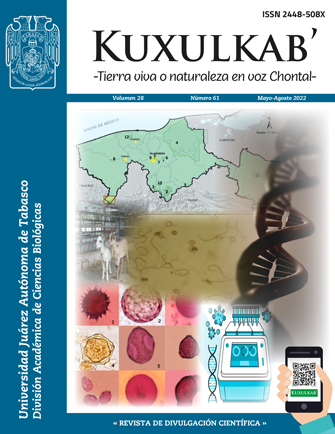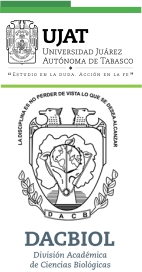BIOCONTROL OF PARASITES IN RUMINANTS WITH FUNGI
DOI:
https://doi.org/10.19136/kuxulkab.a28n61.4532Keywords:
Antagonist, Cattle, Ticks, Fly, SheepAbstract
Fungi are living organisms with some species that act as natural enemies of livestock parasites and can be used to control populations of ticks, flies and gastrointestinal worms. The control of gastrointestinal nematodes with the micro-fungus, 'Duddingtonia flagrans', reduces the parasitic burden of grasslands by trapping and feeding the infective larvae of gastrointestinal worms. Another fungus, 'Metarhizium anisopliae', in field studies reduced the larval tick population in grasslands by 64-100 %. Likewise, 'M. anisopliae', and 'Isaria fumosorosea' were shown to control the horn fly 'Haematobia irritans' by 94-100 % and 90-98 %, respectively. This document discusses how fungi damage parasites and its future use in an integrated parasite control in ruminant livestock.
Downloads
References
Alonso-Díaz, M.A.; García, L.; Galindo-Velasco, E.; Lezama-Gutierrez, R.; Angel-Sahagún, C.A.; Rodríguez-Vivas, R.I. & Fragoso-Sánchez, H. (2007). Evaluation of 'Metarhizium anisopliae' (Hyphomycetes) for the control of 'Boophilus microplus' (Acari: Ixodidae) on naturally infested cattle in the Mexican tropics. Veterinay Parasitolology, 147(3-4): 336-340. DOI «https://doi.org/10.1016/j.vetpar.2007.03.030»
Beys-da Silva, W.O.; Rosa, R.L.; Berger, M.; Coutinho-Rodrigues, C.J.B.; Vainstein, M.H.; Schrank, A.; Bittencourt, V.R.E.P. & Santi, L. (2020). Updating the application of 'Metarhizium anisopliae' to control cattle tick 'Rhipicephalus microplus' (Acari: Ixodidae). Experimental Parasitology, 208: 107812. DOI «https://doi.org/10.1016/j.exppara.2019.107812»
Canhão-Dias M.; Paz-Silva A. & Madeira de Carvalho, L.M. (2020). The efficacy of predatory fungi on the control of gastrointestinal parasites in domestic and wild animals - A systematic review. Veterinary Parasitology, 283: 109173. DOI «https://doi.org/10.1016/j.vetpar.2020.109173»
Cruz-Vázquez, C.; Carvajal Márquez, J.; Lezama Gutiérrez, R.; Vitela-Mendoza, I. & Ángel-Sahagún, C.A. (2017). Efficacy of 'Metarhizium anisopliae' in the control of the horn fly, 'Haematobia irritans' (Diptera: Muscidae), under natural infestation conditions. Veterinaria México OA, 4(2): 1-10. DOI «http://dx.doi.org/10.21753/vmoa.4.2.384»
Dimander, S.O.; Höglund, J.; Uggla, A.; Spörndly, E. & Waller, P.J. (2003). Evaluation of gastro-intestinal nematode of parasite control strategies for first-season grazing cattle in Sweden. Veterinary Parasitology, 111(2-3): 193-209. DOI «https://doi.org/10.1016/S0304-4017(02)00380-1»
Galindo-Velasco, E.; Lezama-Gutiérrez, R.; Cruz-Vázquez, C.; Pescador-Rubio, A.; Ángel-Sahagún, C.A.; Ojeda-Chi, M.M.; Rodríguez-Vivas, R.I. & Contreras-Lara, D. (2015). Efficacy of entomopathogenic fungi (Ascomycetes: Hypocreales) against adult 'Haematobia irritans' (Diptera: Muscidae) under stable conditions in the Mexican dry tropics. Veterinary Parasitology, 209(3-4): 173-178. DOI «https://doi.org/10.1016/j.vetpar.2015.02.025»
Herrera-Manzanilla, F.A.; Ojeda-Robertos, N.F.; González-Garduño, R.; Cámara-Sarmiento, R. & Torres-Acosta, J.F.J. (2017). Gastrointestinal nematode populations with multiple anthelmintic resistance in sheep farms from the hot humid tropics of Mexico. Veterinary Parasitology: Regional Studies and Reports, 9: 29-33. DOI «https://doi.org/10.1016/j.vprsr.2017.04.007»
Hoste, H.; Sotiraki, S.; Landau, S.Y.; Jackson, F. & Beveridge, I. (2010). Goat-nematode interactions: think differently. Trends in Parasitology, 26(8): 376-381. DOI «https://doi.org/10.1016/j.pt.2010.04.007»
Kotze A.C. & Prichard R.K. (2016). Anthelmintic resistance in 'Haemonchus contortus': history, mechanisms and diagnosis. Advances in Parasitology, 93: 397-428. DOI «https://doi.org/10.1016/bs.apar.2016.02.012»
Lawrence, E. (Comp.). (2014). Diccionario de Biología (Trad. Henderson's Dictionary of Biology; p. 622). México: Editorial Trillas. ISBN 978-607-17-2057-3.
Lawrence, E. (Edit.). (2003). Diccionario Akal de Términos Biológicos (12a ed.; Henderson’s Dictionary of Biological Terms; R. Codes Valcarce & Fco. J. Espino Nuño, Trad.; p. 688). Madrid, España: Ediciones Akal. ISBN 84-460-1582X.
Lohmeyer K.H. & Miller, J.A. (2006). Pathogenicity of three formulations of entomopathogenic fungi for control of adult 'Haematobia irritans' (Diptera: Muscidae). Journal of Economic Entomology, 99(6): 1943-1947. DOI «https://doi.org/10.1093/jee/99.6.1943»
Ojeda-Chi, M.M.; Rodriguez-Vivas R.I.; Galindo-Velasco E.; Lezama-Gutiérrez R. & Cruz-Vázquez, C. (2011). Control de 'Rhipicephalus microplus' (Acari: ixodidae) mediante el uso del hongo entomopatógeno 'Metarhizium anisopliae' (Hipocreales: Clavicipitaceae): revisión. Revista Mexicana de Ciencias Pecuarias, 2(2): 177-192. Recuperado el 26 de abril del 2021 de «http://www.scielo.org.mx/scielo.php?script=sci_arttext&pid=S2007-11242011000200005&lng=es&tlng=es»
Ojeda-Chi, M.M.; Rodriguez-Vivas, R.I.; Galindo-Velasco, E. & Lezama-Gutiérrez, R. (2010). Laboratory and field evaluation of 'Metarhizium anisopliae' (Deuteromycotina: Hyphomycetes) for the control of 'Rhipicephalus microplus' (Acari: Ixodidae) in the Mexican tropics. Veterinary Parasitology, 170(3-4): 348-354. DOI «https://doi.org/10.1016/j.vetpar.2010.02.022»
Ojeda-Robertos, N.F., Torres-Acosta, J.F.; Ayala-Burgos, A.J.; Sandoval-Castro, C.A.; Valero-Coss, R.O. & Mendoza-de Gives, P. (2009). Digestibility of 'Duddingtonia flagrans' chlamydospores in ruminants: in vitro and in vivo studies. BMC Veterinary Research, 5(46): 1-7. DOI «https://doi.org/10.1186/1746-6148-5-46»
Ojeda-Robertos, N.F.; Aguilar-Marcelino, L.; Olmedo-Juárez, A.; Luna-Palomera, C.; Peralta-Torres, J.A.; López-Arellano, M.E. & Mendoza-de Gives, P. (2019). in vitro predatory activity of nematophagous fungi isolated from water buffalo feces and from soil in the Mexican southeastern. Brazilian Journal of Veterinary Parasitology, 28(2): 314-319. DOI «https://doi.org/10.1590/S1984-29612019011»
Ojeda-Robertos, N.F.; Mendoza-de Gives, P.; Torres-Acosta, J.F.; Rodríguez-Vivas, R.I. & Aguilar-Caballero, A.J. (2005). Evaluating the effectiveness of a Mexican strain of 'Duddingtonia fragrans' as a biological control agent against gastrointestinal nematodes in goat faeces. Journal of Helmintology, 79(2): 151-157. DOI «https://doi.org/10.1079/joh2005283»
Ojeda-Robertos, N.F.; Torres-Acosta, J.F.J.; Aguilar-Caballero, A.J.; Ayala-Burgos, A.; Cob-Galera, L.A.; Sandoval-Castro, C.A.; Barrientos-Medina, R.C. & Mendoza de Gives, P. (2008). Assessing the efficacy of 'Duddingtonia flagrans' chlamydospores per gram of faeces to control 'Haemonchus contortus' larvae. Veterinary parasitology, 158(4): 329-335. DOI «https://doi.org/10.1016/j.vetpar.2008.08.022»
Paraud, C. & Chartier, C. (2003). Biological control of infective larvae of a gastrointestinal nematode ('Teladorsagia circumcincta') and a small lungworm ('Muellerius capillaris') by 'Duddingtonia flagrans' in goat faeces. Parasitology Research, 89(2): 102-106. DOI «https://doi.org/10.1007/s00436-002-0717-1»
Paraud, C.; Pors, I. & Chartier, C. (2004). Activity of 'Duddingtonia flagrans' on 'Trichostrongylus colubriformis' larvae in goat feces and interaction with a benzimidazole treatment. Small Ruminant Research, 55(1-3): 199-209. DOI «https://doi.org/10.1016/j.smallrumres.2003.12.005»
Quiroz Romero, H.; Figueroa Castillo, J.A.; Ibarra Velarde, F. & López Arellano, M.E. (Eds.). (2011). Epidemiología de enfermedades parasitarias en animales domésticos (p. 642). México: Centro de Investigaciones sobre Enfermedades Infecciosas, Instituto Nacional de Salud Pública; Instituto Nacional de Investigaciones Forestales, Agrícolas y Pecuarias (INIFAP); Comisión México Americana para la Erradicación del Gusano Barrenador del Ganado (COME XA); Instituto Tecnológico de Sonora; Centro Nacional de Servicios de Constatación en Salud Animal; Universidad Autónoma de Querétaro; Universidad Autónoma de Tamaulipas; Universidad Autónoma de Yucatán (UADY); Universidad Nacional Autónoma de México (UNAM); Instituto Tecnológico y de Estudios Superiores de Monterrey (ITESM); Universidad Autónoma de Baja California; Universidad Autónoma Metropolitana (UAM). ISBN: 978-607-00-4015-3 (versión electrónica CD-ROM). Recuperado de «https://acortar.link/wJZCgp»
Rodríguez Vivas, R.I.; Torres Acosta, J.F.J.; Cruz Vázquez, C.; Almazán García, C.; Alcalá Canto, Y.; Alonso Díaz, M.A.; Chan Pérez, J.I.; Domínguez García, D.I.; Fernández Salas, A.; Figueroa Castillo, J.A.; Galindo Velasco, E.; Lagunes Quintanilla, R.E.; López Arellano, M.E.; Martínez Ibáñez, F.; Martínez Ortíz de Montellano, C.; Mendoza de Gives, P.; Ojeda Robertos, N.F.; Ortega Pacheco, A.; Rosario Cruz, R.; Rosado Aguilar, J.A.; Torres Rodríguez, L. & Vitela Mendoza, I. (2018). Epidemiología y control de garrapatas, moscas y nematodos gastrointestinales que afectan a los bovinos en México. En: González Padilla, E. & Dávalos Flores, J.L. (Coords.); Estado del arte sobre investigación e innovación tecnológica en ganadería bovina tropical (Libro técnico, 2da ed.; pp: 255-271). México: Red de Investigación e Innovación Tecnológica para la Ganadería Bovina Tropical (REDGATRO); Universidad Nacional Autónoma de México (UNAM); Instituto Nacional de Investigaciones Forestales, Agrícolas y Pecuarias (INIFAP); Consejo Nacional de Ciencia y Tecnología (CONACYT). Recuperado de «https://redgatro.fmvz.unam.mx/docs/Estado_arte.pdf»
Roy, H.E. & Pell, J.K. (2000). Interactions between entomopathogenic fungi and other natural enemies: implications for biological control. Biocontrol Science and Technology, 10(6): 737-752. DOI «https://doi.org/10.1080/09583150020011708»
Saito, K.C.; Bechara, G.H.; Nunes, E.T.; de Oliveira, P.R.; Denardi, S.E. & Camargo Mathias, M.I. (2005). Morphological, histological, and ultrastructural studies of the ovary of the cattle-tick 'Boophilus microplus' (Canestrini, 1887) (Acari: Ixodidae). Veterinary Parasitology, 129(3-4): 299-311. DOI «https://doi.org/10.1016/j.vetpar.2004.09.020»
Szewc, M.; De Waal, T. & Zintl, A. (2021). Biological methods for the control of gastrointestinal nematodes. Veterinary Journal, 268: 105602. DOI «https://doi.org/10.1016/j.tvjl.2020.105602»
Terrill, T.H.; Larsen, M.; Samples, O.; Husted, S.; Miller, J.H.; Kaplan, R.M. & Gelaye, S. (2004). Capability of the nematode-trapping fungus 'Duddingtonia flagrans' to reduce infective larvae of gastrointestinal nematodes in goat faeces in the southeastern United States: dose titration and dose time interval studies. Veterinary Parasitology, 120(4): 285-296. DOI: «https://doi.org/10.1016/j.vetpar.2003.09.024»
Torres-Acosta, J.F.J.; Mendoza-de Gives, P.; Aguilar-Caballero, A.J. & Cuéllar-Ordaz, J.A. (2012). Anthelmintic resistance in sheep farms: update of the situation in the American continent. Veterinary Parasitology, 189(1): 89-96. DOI «https://doi.org/10.1016/j.vetpar.2012.03.037»
Waghorn, T.S.; Leathwick, D.M.; Chen, L.Y. & Skipp, R.A. (2003). Efficacy of the nematode-trapping fungus 'Duddingtonia flagrans' against three species of gastro-intestinal nematodes in laboratory faecal cultures from sheep and goats. Veterinary Parasitology, 118(3-4): 227-234. DOI «https://doi.org/10.1016/j.vetpar.2003.09.018»
Zajac, A.M. & Garza, J. (2020). Biology, epidemiology, and control of gastrointestinal nematodes of small ruminants. Veterinary Clinics of North American: Food Animal Practice, 36(1): 73-87. DOI «https://doi.org/10.1016/j.cvfa.2019.12.005»
Downloads
Published
Issue
Section
License
Copyright (c) 2022 Kuxulkab'

This work is licensed under a Creative Commons Attribution-NonCommercial-ShareAlike 4.0 International License.
Los autores que publiquen en Kuxulkab' aceptan las siguientes condiciones como política de acceso abierto:
1. Que conservan los derechos de autor y ceden a la revista el derecho de la primera publicación, con el trabajo registrado con la licencia de atribucion de "Creative Commons", que permite a terceros utilizar lo publicado siempre que mencionen la autoría del trabajo y a la primera publicación en esta revista.
2. El autor puede realizar otros acuerdos contractuales independientes o adicionales para la distribución no exclusiva de la versión del artículo publicado en esta revista, como por ejemplo incluirlo en un repositorio institucional o publicarlo en un libro, siempre que se indique claramente que el trabajo se publicó por primera vez en esta revista.












